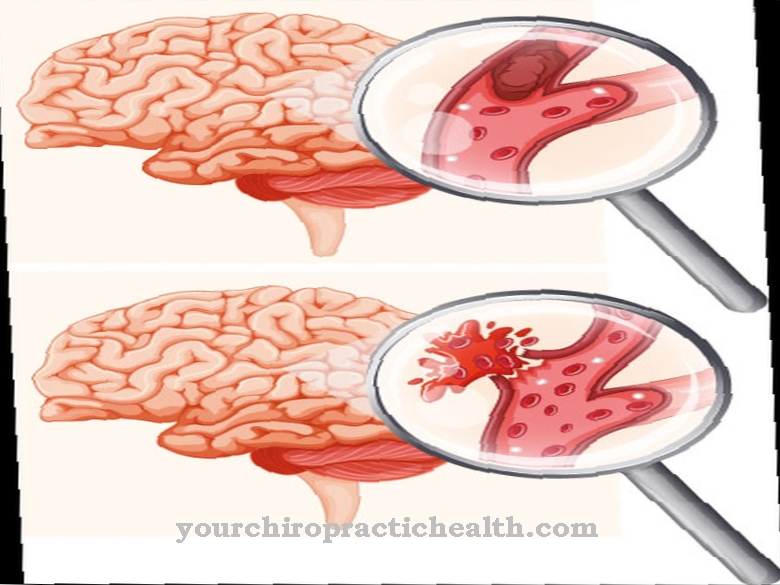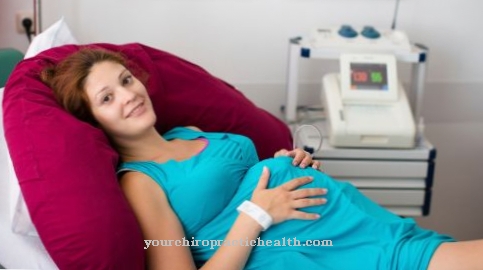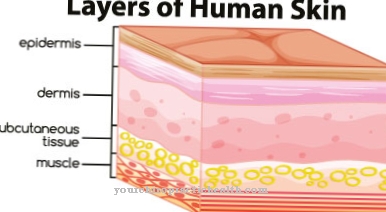In the Urethrocystocele the anterior wall of the vagina moves deeper and allows the urinary bladder and urinary tract, which is anterior to it, to slide downwards. The phenomenon is often due to a weakness of the holding apparatus in the pelvic floor. When men experience slipping of the bladder and urinary tract, the most common condition is an inguinal hernia.
What is a urethrocystocele?
In the case of a proplapse, a certain organ is displaced from its physiological position. The prolapse can affect a wide variety of organs and is based on an extremely variable spectrum of causes, which depend on the organ affected. The cystocele is a prolapse of the urinary bladder. With this phenomenon, the bladder shifts into a so-called hernial sac. If, in addition to the bladder, the urethra is also affected, then there is one Urethrocystocele the speech.
Every prolapse is a pathological phenomenon. Urethrocystocele almost exclusively affects women. The vaginal wall plays a causal role in this context. Both the bladder and the urinary tract are located anatomically anterior to the vagina. If the anterior vaginal wall slips deeper, this can lead to a prolapse of the urinary bladder and urinary tract in the sense of a urethrocystocele.
In most cases, the result is bladder incontinence. The urethrocystocele is often described clinically as a cystocele with urethrocele, with a prolapse of the anterior vaginal wall usually being given as the cause.
causes
The cause of urethrocystocele is a prolapse of the anterior vaginal wall, which manifests itself in a weakness of the supporting apparatus. In most cases, the patients are women whose bladder and urinary tract are everted into the anterior vaginal wall. In some patients, the prolapse of the bladder and urinary tract is so significant that the organs at the vaginal entrance are visible or even slide further forward.
In most cases, urethrocystocele is the secondary event of uterine or vaginal prolapse. This process is mostly due to a weakness of the muscles in the pelvis. A weakness of the ligamentous apparatus and the levator ani muscle or urogenital diaphragm in the pelvic floor can also play a causative role. The holding devices of the organs can become inadequate, for example, in the context of weak connective tissue, after physical overexertion, due to obesity or multiple vaginal births.
In this context, there is initially a descent that causes the organs to sink. The phenomenon of the urethrocystocele can develop from this descent. If the patient is a man, the phenomenon is usually causally related to femoral or inguinal hernias. In this case, it is a fracture into which the organs invade.
Symptoms, ailments & signs
In the early phase of a urethrocystocele, the patient's urinary bladder and urinary tract descend from their physiological position in a ventral direction. Only in rare cases does this phenomenon cause pain or other complaints in the early phase. In the course of the disease, symptoms such as pain during sexual intercourse appear.
In addition, the function of the urinary bladder can be disturbed and thus cause urination disorders. Often the patients also suffer from recurring urinary tract infections. However, voiding disorders are the main symptom and can manifest themselves, for example, in urinary retention or in frequent urination with a reduced amount of urine.
Urinary incontinence is common in the late stages. Most of the patients remain asymptomatic even in the late stages of the phenomenon and only notice the prolapse of the organs in extreme cases in which the organs slide up to the vaginal entrance.
Diagnosis & course of disease
In particular, the diagnosis of a cystocele of the bladder can be made by simple palpation. In this phenomenon, a more or less distinct protrusion can be felt on the anterior wall of the vagina, which is usually sufficient for a diagnosis. When the patient is asked to press, the protrusion sinks and becomes even more prominent. In most cases, the suspicion of a urethrocystocele is confirmed by ultrasound. The prognosis is considered excellent.
Complications
With urethrocystocele, those affected primarily suffer from severe pain. These can also occur at night and in the form of resting pain and thus have a very negative effect on the patient's everyday life. The pain often spreads to the neighboring regions of the body and can also lead to severe discomfort there.
The pain occurs especially during sexual intercourse, so that there can also be tension with your own partner. Urination is also often associated with pain. Those affected also often suffer from urinary tract infections. There is also incontinence, which also has a negative effect on the patient's everyday life.
Due to the symptoms of the urethrocystocele, many patients also suffer from psychological complaints or from depression. Some sufferers are also ashamed of the symptoms. Treatment of urethrocystocele depends heavily on its cause.
In some cases, the symptoms can be resolved through various training sessions or with the help of medication. In severe cases, surgical interventions are necessary. As a rule, there are no particular complications. Furthermore, in most cases the urethrocystocele does not have a negative effect on the life expectancy of the patient
When should you go to the doctor?
With a urethrocystocele, the person affected is usually always dependent on medical treatment and examination, as this disease cannot heal independently. The earlier a doctor is consulted, the better the further course of this disease is usually. Therefore, it is highly recommended that you contact a doctor at the first symptoms and signs of this disease.
A doctor should be consulted if the person concerned suffers from severe pain during sexual intercourse. This pain can also spread to the abdomen.Furthermore, urination disorders or very frequent urinary tract infections point to this disease and must be examined by a doctor if they occur over a longer period of time and for no particular reason.
Those affected often have to urinate and often suffer from mental disorders as a result. Urethrocystocele can be treated by a urologist. The further course depends very much on the time of diagnosis and the progression of the disease, so that no general prediction can be made.
Treatment & Therapy
In urethrocystocele therapy, the organs are returned to their physiologically natural position. In most cases, this process requires surgery. Depending on the cause, further treatment may also have to take place. In women, this further treatment corresponds in most cases to a training of the holding apparatus, for example stabilizing pelvic floor training.
In men, an inguinal hernia that may have caused it must also be treated. This treatment takes place as part of the repositioning operation and above all ensures that the hernia can no longer emerge in the future. Treatment of an indirect hernia in this case is not the same as treatment of direct hernia.
The opening of a direct hernia is surgically closed. Indirect breaks rely on the doctor leaving an opening for the spermatic cord to remain. In principle, both operations go back to the Italian Bassini.
prevention
The urethrocystocele can be prevented to a certain extent. Women can, for example, attend pelvic floor training as a preventive measure. Through the training units you strengthen your pelvic floor muscles, which play an important role in the holding apparatus of the urinary bladder and urinary tract. The organs are stabilized in their anatomical position and the probability of an anterior sliding is reduced. For men, the same preventive measures apply for urethrocystocele as for inguinal and thigh hernias.
Aftercare
After the successful treatment of a urethrocystocele, intensive follow-up care should always take place, as this is the only way to identify and treat secondary diseases and recurrence of a urethrocystocele in good time. Follow-up treatment consists of regular gynecological and, if urinary incontinence has occurred, urological examinations.
Imaging (CT, ultrasound, cystography) should also be performed here, as this is the only way to reliably detect a renewed urethrocystocele, especially in the early stages. If there is permanent urinary incontinence, this must be treated urologically. Any scarring in the mucous membrane of the vagina caused by the treatment of the urethrocystocele should be treated gynecologically.
If the treatment results in problems with sexual intercourse, this should also be discussed with the attending gynecologist, who can recommend certain countermeasures and / or prescribe special medication and ointments. If permanent infertility has developed as a result of the treatment of the urethrocystocele, this must also be treated gynecologically, if possible.
Since sexual infertility as well as permanent urinary incontinence can also result in massive social and psychological problems, psychotherapeutic support can also be necessary and helpful. In particular, if depression occurs as a long-term consequence of the disease, it must be treated psychotherapeutically but also psychiatric (mediakamentous). Behavioral therapy can also help in the case of sexual restrictions and should therefore be considered.
You can do that yourself
A urethrocystocele is usually treated surgically and with medication. After an operation, the patient must take it easy and inform the doctor about any physical complaints. Consult a doctor in the event of severe pain, problems urinating or cramps. The same applies if suddenly dizziness or other signs of internal bleeding occur.
After the surgery, patients should stay at home for at least two to four weeks. Physical activity can help you recover more quickly later. To begin with, the most important measures are to provide the body with sufficient fluids and essential nutrients and to sleep a lot. These measures are usually sufficient to optimally support conservative therapy.
If there are severe symptoms, a hospital must be visited. This is necessary again at the end of the treatment. The doctor will carefully examine the vaginal wall and, if necessary, the urethra and bladder again. If urinary incontinence has already occurred, adult diapers or panty liners must continue to be worn and the pelvic floor must be specifically strengthened through pelvic floor training.













.jpg)

.jpg)
.jpg)











.jpg)